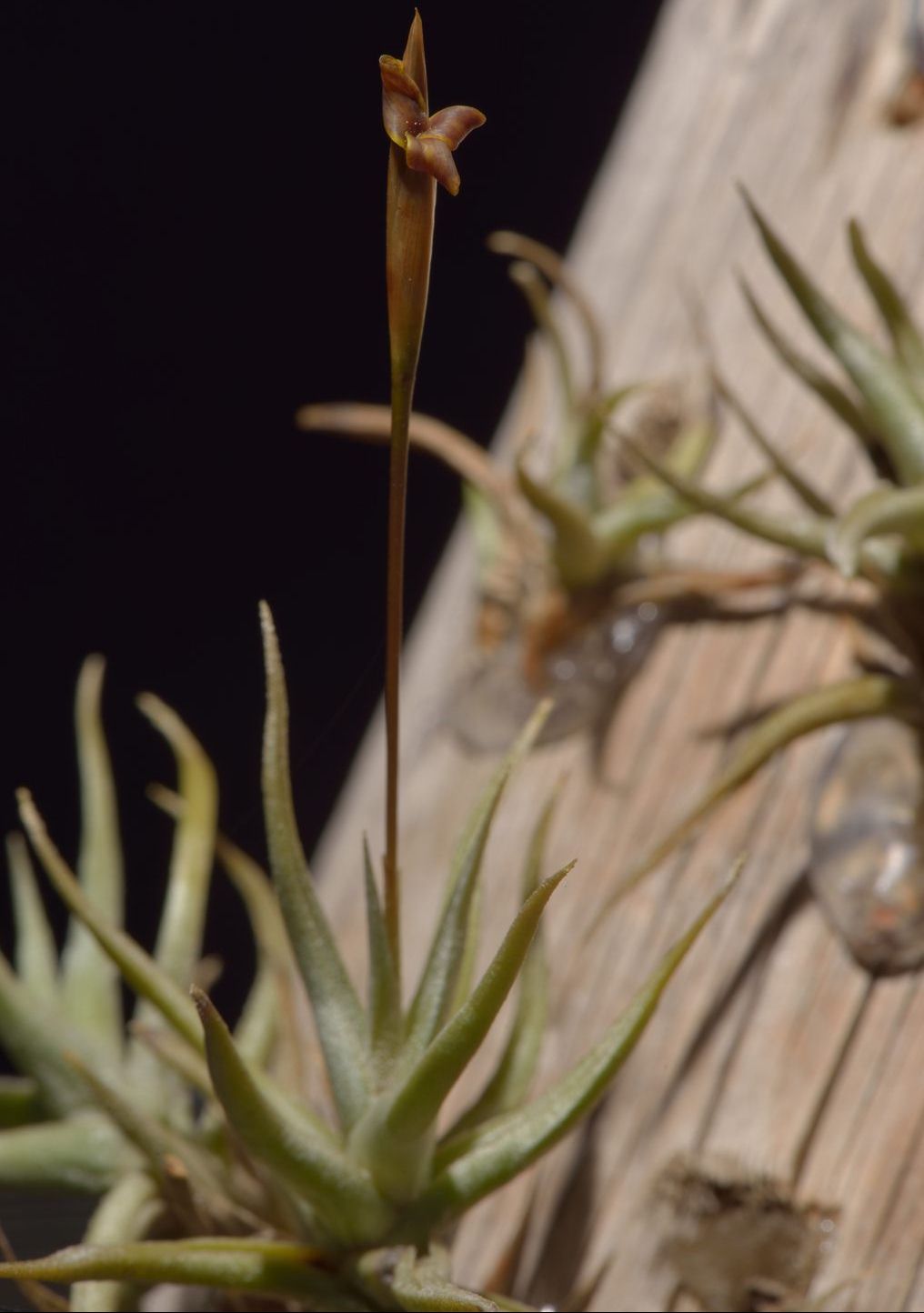
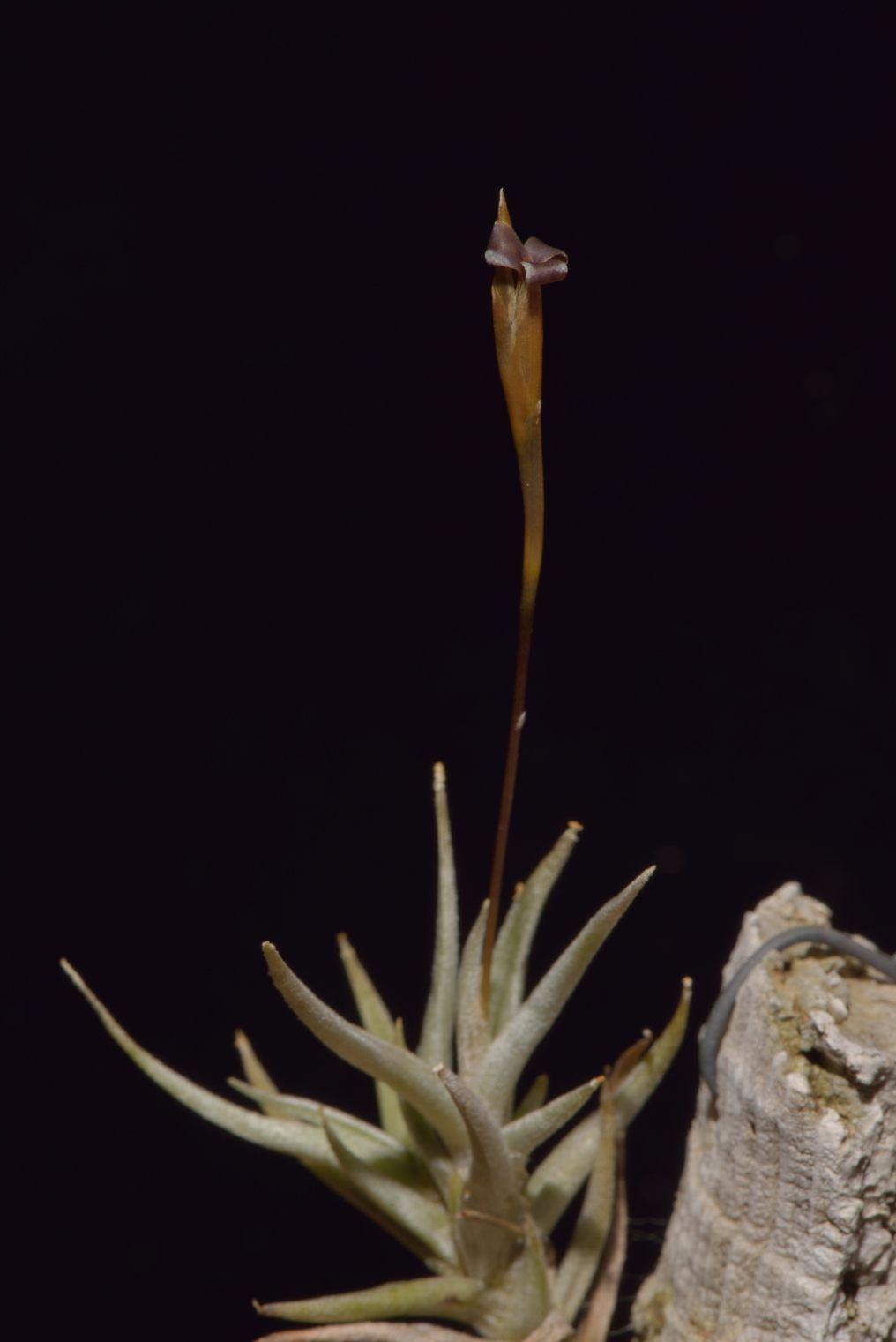

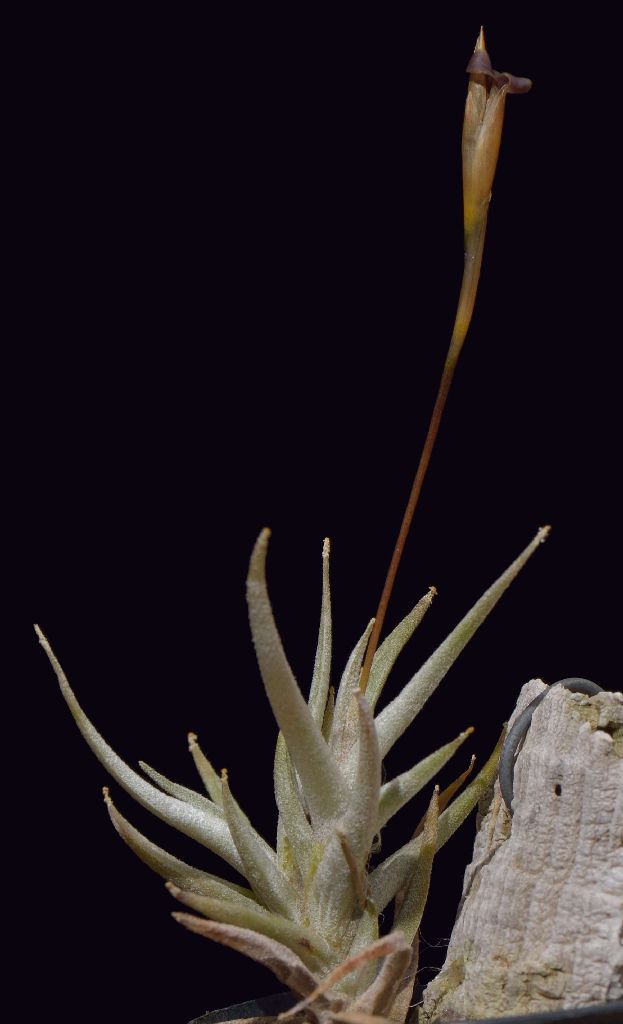


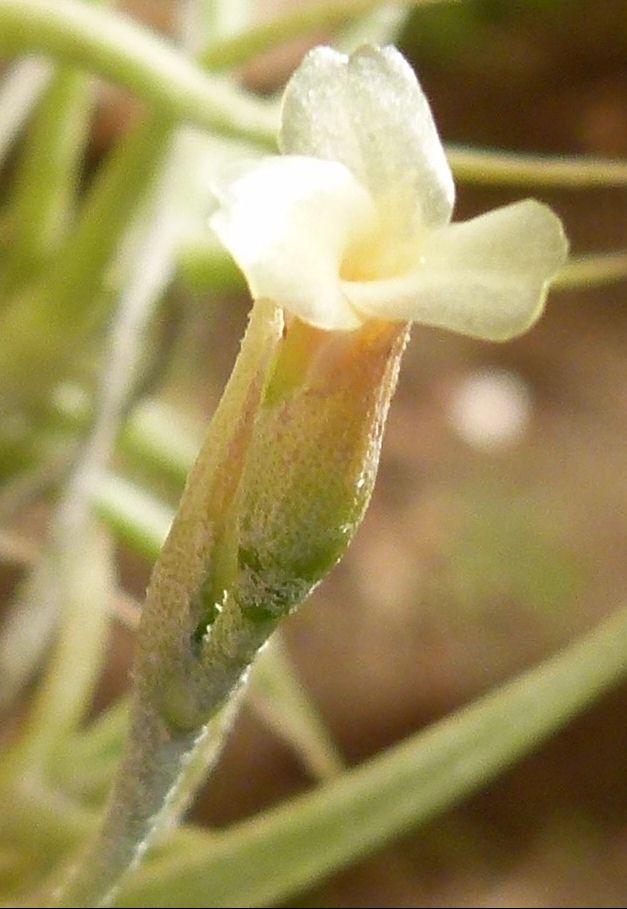
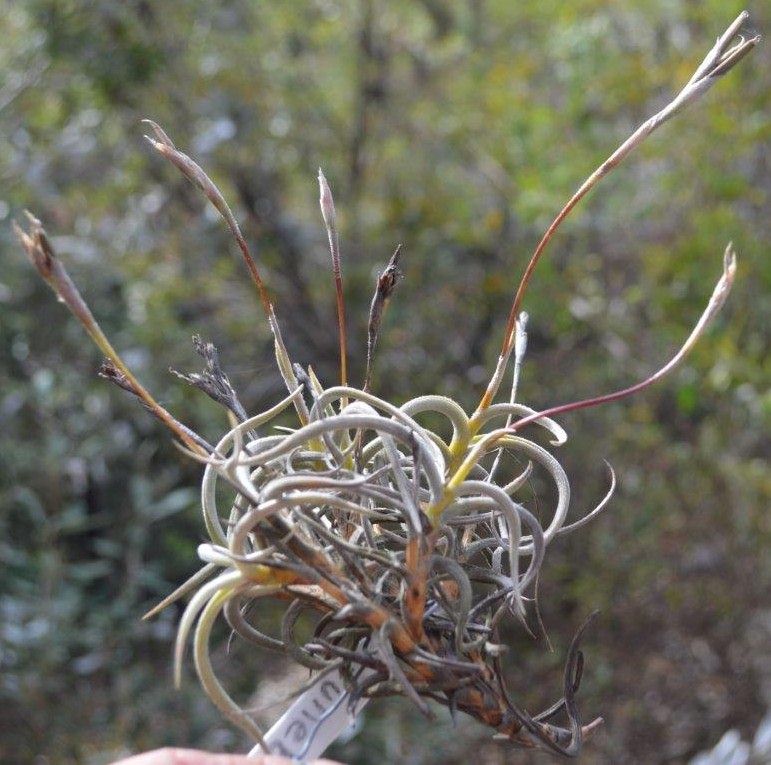
George Nieuwenhoven ... "T. rectangula and T. funebris, if you don’t look too closely you would swear they are the same species."
From Derek Butcher ....
Die Untergattung Diaphoranthema von Tillandsia Linnaeus
Part 3: Tillandsia rectangula Aggregate By W Till in Die Brom. 1: 15-19. 1991
The species of this relationship are spread on the east side of the southern Andes from North Bolivia to Patagonia. The most western occurrences lie close to Lake Titicaca as well as the State of Mendoza (Argentinia), the eastern near Bahia Blanca (Province of Buenos Aires), in the Sierra de Cordoba as well as at the western edge of the Paraguayan Chaco. Altogether, populating highlands from almost sea level to over 3200 m s. m. ( T. pedicellata). The following species in this Aggregate are: T. funebris Castellanos, T. rectangula Baker, T. aizoides Mez in C.DC. and T. pedicellata (Mez in C.DC.) Castellanos (incl. T. coarctata Gillies ex Baker.) the name pedicellata will probably be withdrawn in favour of coactata. Besides these, there are T. erecta Gillies ex Baker (incl. T. rigida Gillies ex Baker) and T. brealitoensis L. Hromadnik in Till & Hromadnik which are treated, if not already certainly in this Aggregate are very close to the 4 already mentioned.
All species have spiral leaf positions and more or less strongly outstanding stem formation. The inflorescences are usually single flowered, rarely 2-flowered. In the rectangula-Aggregate floral bracts and sepals are glabrous, with T. erecta and above all T. brealitoensis distinctly strongly scaled.
T. funebris, T. rectangula, T. aizoides and T. pedicellata form a morphological row: the leaves are arranged on an increasingly long stem where the upper rows are shorter and thinner and more and more dense. The flowers become smaller and the scape clearly shorter.
T. funebris (Map1, fig. 1, 7) has very strong, to 50 mm long and 3-5 mm wide leaves with glabrous sheaths and appressed scaled blades, the upperside with a single furrow, however not visibly long nerved. The glabrous scape has 1(-2) scape bracts and 1 to 2-flowered inflorescence. The floral bracts are (10,6 -) 14,5-15,5 mm long and 4,5-6,2 ( -7) mm wide. {All measurements refer to flat extended floral organs} The sepals measure 9-10,5x3-4 mm, the usually rolled back, dark-yellow, with brown long stripes, or brown petals 13-16,5x3,7-3,9 mm. The flower is scented maintaining it through the night, later in the morning the scent is even stronger. The species is from central Bolivia to the Argentinian Province of Catamarca and spreading to the western edge of the Paraguayan Chaco. It is epiphytic, usually on thorn shrub vegetation, in highlands from 500 to 1900 m s. m.; the larger ones reach over 1200 m s.m. in Bolivia. Very close to the previous species is T. rectangula. Its stiff leaves are to 20 mm long and 2-3 mm wide, the sheath is glabrous, the blades appressed scaled and not long nerved. The glabrous scape usually has one scape bracts and a 1-flowered inflorescence. The flower bracts are 6,5-8 mm long and 3,7-4,5 mm wide. The sepals measure 7,5-9x2,5-3,6 mm, bent backwards, the yellow brown to brown, often yellowish spotted or yellowish edged petals 11,8-13,5x2,5-2,7 mm. The flower smells like T. funebris.
T. rectangula (Map2, fig. 2, 8) is from central Bolivia along the Andean borders spreading into the Argentinian Province of San Luis. It advances southwards and into drier areas the same as T. funebris. It is an epiphyte of the thorn shrub vegetation (Mountain) in highlands 700-1100 m s. m. and climbing to almost 2500 m s. m. in Bolivia.
Clearly stemmed and with short dense framework of leaves is T. aizoides (Map 3, fig., 3, 9). Its leaves to 10 mm long and 2 mm wide and appressed scaled. The glabrous scape is at flowering time short and has 1 to 2 scape bracts under the flower. The floral bracts are 5,1-5,2 mm long and 2,8 - 3 mm wide. The sepals are 5,6 - 6,5x2,1-2,3 mm, the yellowish brown to brown ( rarely dark brown) from time to time spotted petals 8-11,3x1,6-2,5 mm. The flowers maintain their scent through the night.
This species is from Southern Bolivia along the east side of the Andes into the Argentinian provinces of La Rioja and San Juan and spreading to the Sierra de Cordoba. It is usually epiphytic, more rarely on rocks and prefers highlands of 800-1400 m s. m., climbing to over 1700 m s. m. however. Rarely, there are natural hybrids between T. aizoides and T. pedicellata.
The fourth species in this Aggregate is T. pedicellata (Map 4, fig. 6, 12). It was united by SMITH & DOWNS (1977) with T. bryoides Grisebach respectively, auct. , however, has a flower structure to distinguish and show their true relationship (eg. glabrous 3 (-5) -nerved sepal). Its leaves are 8 mm long (often however shorter) and 1 mm wide, appressed scales and stiffly erect ( however, recently a form was found in the Argentinian province of Salta with bent outwards leaf tips. The scape is lacking at flowering, however, it clearly lengthens towards the time of seed setting. The single flower sits at the top of the shoot between the leaves. The floral bracts are (6 -) 6,5, -7, mm long and (2,6 -) 3-3,3 mm wide. The sepals measure 5,8-6,5x1,7-1,9 mm and are mostly 3 nerved with generally 1 mid nerve and 2 very short side nerves, the dark-violet or dark brown petals are spreading and measure 8-8,7x1,5-1,8 mm. Flower scent was not determined.
T. pedicellata is found locally in Bolivia near La Paz and near Cochabamba, the main habitat begins in South Bolivia and stretches along the Andean border in the dry areas to the Argentinian provinces of Mendoza and San Luis. With some isolated occurrences in the provinces of Buenos Aires, La Pampa, Rio Negro and Chubut it is the farthest south for a Tillandsia. The plants usually grow as epiphytes, seldom on rocks and are usually found at a height between 800 and 1700 m s. m. ( Argentina). In the southern areas T. pedicellata grows however almost at sea level, whereas in Bolivia, it lives largely at a height between 1900 and 3100 m.
Maintaining the 4 above discussed species represent a well recognizable allied unit with advances in morphological reduction and increasing habitat expansion towards the south, the two following species are only just related. Their close position to the rectangula Aggregate. is that all the vegetative characteristics confirm this addition, while somewhat maintaining the variation in floral characteristics. How important any premature, phylogenetic indication of significant hybridisation is, is unclear.
T. erecta (Map 1, fig. 4, 10) is similar in habit to T. funebris, however it has more erect leaves with a conspicuous long nerve. The flowers are singular on a glabrous scape with 1 scape bract. The floral bract is glabrous or in the upper two-thirds quite laxly scaled, 12-13,5 mm long and 5,7-6,1 mm wide. The sepals are almost glabrous or quite laxly scaled and measure 10-11,5x3-4 mm. The flower often as not, is self pollinating and scentless. The dirty greenish yellow petals are 9-12,5 mm long and 2,5-3 mm wide. The species is local, spreading in the western central Argentina in the provinces of La Rioja and Mendoza. It is epiphytic, primarily in the Chanar brea at heights of 1300-1600 m s. m.
T. brealitoensis (Map 3, fig. 5, 11) is very similar in habit to T. aizoides. It can be separated, however, by the 1 to 2 flowered inflorescence with quite robust scape and the construction of the flowers: the scaled floral bracts measure 7,6-11,6x4,8-6,8 mm and the scaled sepals 7,6-l0x2,8-3,9 mm; the petals are violet to dark-violet and measure 9,9-12x2,4-3 mm. The species is only known from the type locality in the Valle Calchaquies, province of Salta (Argentina), where it is epiphytic on shrubs at 2300-2400 m s. m.
Desc from S&D p882-4
Plant small; stems many from a single point, forming a globose mass, to 5 or rarely 7 cm long, much branched; roots present.
Leaves densely distichous but often appearing polystichous due to the torsion and crowding of the stems, rarely over 2 cm long;
Sheaths distinct, suborbicular, ca 6 mm long, glabrous except for the extreme apex, densely imbricate making the stem appear stout, scarious, several-nerved with broad nerveless margins;
Blades spreading or recurved, more or less contorted, triangular-subulate, 2 mm in diameter, strongly angled, often distinctly carinate below, convolute above, attenuate, densely cinereous-lepidote with small nearly symmetrical subappressed to reflexed-pruinose scales.
Scape distinct or almost none, erect to ascending, to 4 cm long, but usually not over 2 cm, apparently always terminal, slender, strongly angled, glabrous, naked for most of its length or sometimes bearing an involute-clasping bract midway;
Scape-bracts lanceolate, acute or obtuse, several-nerved, subcoriaceous, even, glabrous or occasionally pale-appressed-lepidote, usually 2 in number, one at the extreme base of the scape and mostly hidden by the leaves, the other just below the inflorescence.
Inflorescence 1-flowered.
Floral bract like the upper scape-bract but smaller, much shorter than the sepals;
Flower subsessile.
Sepals lance-elliptic, acute or obtuse, to 10 mm long, several-nerved, chartaceous, even, glabrous or sparsely lepidote, equally connate for 2 mm or slightly longer posteriorly;
Petals yellow, the blade spreading at anthesis, subrhombic, obtuse, 4.5 mm long;
Stamens included; anthers linear, obtuse, over 1 mm long; filaments exceeding the pistil; ovary subprismatic, tapering into the thick style; stigma capitate.
Capsule slenderly cylindric, abruptly short-beaked, 20 mm long.
Type. Lorentz 127 e p (holotype K, GH photo) near Cordoba, Argentina. DISTRIBUTION. Epiphytic, 500 m alt, Bolivia, northwestern Argentina.
Lorentz 126 e p (GOET) appears to be a hybrid of T. rectangula and some form of T. capillaris.
Tillandsia rectangula Baker, Jour. Bot. London 16: 238. 1878.
Tillandsia propinqua var rectangula Grisebach, in Lorentz Pl. Argent. Exsic., No. 126-127.
Leafy stems simple or forked, about an inch long.
Leaves about a dozen to a fully-developed simple stem, half an inch long, linear-subulate from a clasping lanceolate base, spreading, half a line broad where they leave the stem, narrowed gradually from the base to the point, deeply channelled on the lower part of the face, thinly lepidots all over, with one deep lateral groove on each side of the lower half.
Peduncle filiform, terminal, 1- flowered, about an inch long, with sometimes a bract at the middle.
Bract that clasps the flower oblong, ¼ inch long.
Calyx 1/3 inch long; sepals obtuse.
Capsules half an inch long; valves a line broad.
Argentine territory at Cordoba, Lorentz, 126! 127! Midway between propinqua and rigida.
Desc from S&D p882
Plant small. rarely over 10 cm long including the inflorescence; stems several from a single point, densely massed, simple or few-branched, 2-5 cm long; roots present.
Leaves densely distichous or polystichous, to 5 cm long;
Sheaths distinct, suborbicular to reniform, densely imbricate, making the stem appear stout, 5-8 mm long, glabrous below, subcoriaceous, many-nerved with broad nerveless membranous margins;
Blades divergent to reflexed, more or less contorted, triangular-subulate, 2-3 mm in diameter, strongly angled but not at all sulcate-striate, often distinctly keeled below, convolute above, attenuate, densely cinereous-lepidote with small nearly symmetrical subappressed to reflexed-pruinose scales.
Scape distinct, always terminal (?), erect, to 5 cm long, slen¬der, glabrous, angled, naked for most of its length;
Scape-bracts oblong-lanceolate, acute, to 17 mm long but usually 13 mm, subcoriaceous, many-nerved, even, 2 in number, usually a somewhat lepidote one near the base of the scape and a glabrous one just below the inflorescence.
Inflorescence 1-2-flowered, glabrous.
Floral bracts like the upper scape-bract but more ovate and progressively smaller, from slightly shorter to slightly longer than the sepals, even;
Rhachis like the scape and nearly as thick, swollen at the nodes;
Flowers subsessile, erect.
Sepals lanceolate, acute, even, many-nerved, 10 mm long, equally connate for about 2 mm;
Petals 13 mm long, dark orange-brown when dry, coffee-colored when fresh, blade distinct, subrhombic, obtuse, spreading and often circinnate at anthesis;
Stamens deeply included; anthers basifixed, linear, acutish, less than 2 mm long; filaments slightly shorter than the pistil; ovary ellipsoid, obtusely angled, contracted into the short thick style; stigma broadly capitate.
Capsule slenderly cylindric, 2 cm long; seeds few.
Type. Schreiter 1689 (holotype BA; B, GH, LIL, isotypes), Vipos, Trancas, Tucuman, Argentina, Sep 1923.
DISTRIBUTION. Epiphytic in dry forest, 500-850 m alt, Bolivia, Paraguay, northern Argentina.
Detail from Studies in Bromeliaceae by Lyman Smith VI p189. 1935
This species is probably a close relative of T. aizoides, having the same trait of an isolated scape-bract just below the inflorescence, but its larger and spreading leaves distinguish it at first glance. In habit, T. funebris closely resembles T. erecta.
Castellanos records larger measurements for parts of the inflorescence than I have been able to find.
T. funebris is one of the species which appear transitional between Phytarrhiza and Diaphoranthema.
Email Date: Mon, 30 Nov 1998 "Dr. Walter Till"
Another question is about the real difference between T. funebris and T. rectangula. I have many forms which have various leaf length, but I could not find any difference in the flowers. Do you think T. funebris and T. rectangula are really two different species???
These two are certainly closely related. Aside of the leaf length, which works in most cases to separate both, I regard the floral bract character as the best: half as long as the sepals = rectangula, as long as the sepals = funebris. The minority of intermediate specimens might be hybrids. Unless isozyme work has been done I hesitate to merge both as subspecies. Regards, Walter.
From: "Dr. Walter Till" To: "'Butcher'"
Date: 30 Nov 1998
Derek:
Recently a Japanese fellow asked about the difference between T. funebris and T. rectangula and he was satisfied with your reply. Eric Gouda and myself have been discussing overlaps and whether these are closely related. I am getting confused. Where do you see their relationship?
T. funebris is certainly closely related to T. rectangula and has a range of distribution farther north than the latter. It is larger in all dimensions and especially when in flower it is easily recognized by its large floral bracts. T. rectangula is usually well separated and recognized. I confess, however, that there are some cases where one can begin hesitating to separate. Whether these plants are hybrids or whether both species intergrade is not yet clear. In the latter case it would be better to treat both taxa of subspecies. I still have T. funebris WT10265 and T. rectangula HT87-94 which I use in my comparisons with others in this small group.
I recommend not to try to separate too much within the even more complex T. myosura group. Without modern methods of isozyme comparison I guess this assemblage cannot be resolved sufficiently in taxonomic terms.
Best regards, Walter
Date: Tue, 9 Mar 1999 From: Eric Gouda To: Multiple recipients of list
Subject: Re: T. funebris vs. T. rectangula /scape-bract
I've one plant of a typical T. funebris flowering at this moment, with about 13 inflorescences (3, 2-flowered and the rest one flowered) and floral bracts of the first flower about equalling the sepals. That of the second flower (if any) distinctly shorter than the sepals. Petals are dark-brown with some what yellowish margins.
All single flowered inflorescences had two floral-bracts and three of them did have one scape bract (not counting the first empty floral bract that may be considered a scape bract too), more than 1 cm below the spike.
A TALE OF TWO MICE
OR T. myosura versus T. caliginosa by Derek Butcher, S.A. in Bromeletter 32(5): 8-9, 1994
This tale starts early in 1993 when an article appeared in the BSI Journal 1993 page 24, and which was a reprint of a previous article in 1975 by George Kalmbacher entitled "A Tale of a Mouse-Tail - with details". In between these 2 dates another plant with leaves like a mouse-tail had been named and I wrote an article for the BSI Journal pointing out the problem but for various reasons it was not published.
Let us go back to the late 1980's when I acquired copies of Rauh's Bromelienstudien and I had to quickly learn botanical German to help me understand these works. I translated, amongst many others, the description of a plant called Tillandsia crocata var. tristis. We all know that T. crocata is a pretty little plant with a large yellow flower and an exquisite scent. Here we had a variety with a small flower that was dirty yellowish brown. Needless to say I wanted to acquire one!
The next thing I found out was that Dr. Walter Till from Vienna had named a Tillandsia caliginosa and had split up what Smith & Downs had treated as T. myosura. The T. crocata var. tristis became a synonym of T. caliginosa. So the field was reduced to T. caliginosa and T. myosura.
It is interesting to note that in 1935, Lyman Smith indicated his worries about 2 of the collections within his concept of T. myosura and it took 50 years before anything was done about it.
I still didn't know what the real difference was and I went to the World Conference in Tampa in 1992 with high hopes of a solution. Instead of being rare, T. caliginosa was on sale everywhere but no T. myosura. In addition, this T. caliginosa looked like what I had been growing as T. myosura. When I asked the obvious question I was told it was easy to tell them apart but no one could tell me how!
So I went to the trouble of importinq this "new" species with the usual traumas and costs of quarantine. The plants survived and when placed side by side with the 'Aussie' T. myosura I could find no difference.
Dr. Walter Till is the current World authority on the sub genus of Tillandsia called Diaphoranthema. This sub genus includes T. usneoides, but generally speaking if the plant is small & has very small flowers with exciting colours like green, dirty yellow, brown, dark violet to black you are talking about Diaphoranthema. I felt I just had to contact Dr. Till in Vienna and as luck would have it he writes and speaks English. I sent him a few bits of the Aussie "T. myosura" and guess what?! It is T. caliginosa.
What is the difference between the two? Well, Dr. Till says this is what I have to look for....
T. myosura. Petals are always pure yellow in different hues, flower fragrance is not very strong. The leaves are not strictly distichous, very rigid and their sheaths, glabrous (naked) to lepidote. The inflorescence axis is often somewhat flexuous. Its habitat is in the arid areas near Cordoba, Argentina.
T. caliginosa. Petals are usually dark brown (hence the name), or if brownish yellow then spotted, flower fragrance is rather strong, the leaves are nearly exactly distichous, rather soft, and their sheaths strikingly glabrous. The inflorescence axis is usually nearly straight with rather long internodes. It is widespread in northern most Argentina and Bolivia.
By the way, if you cannot understand some of these terms I suggest you acquire a copy of "The Amateur's Guide to the Greyish Leaved Tillandsioideae".
The plant I call the 'Aussie' T. myosura came to Adelaide via Queensland about 1980 and offsets so prolifically that it has became the most common Tillandsia in Adelaide. For the first few years we kept finding seed pods but had never seen it flower. Maureen Hick was the first to claim a sighting and she pronounced its colour was dirty yellow. This spurred others to be on the look out but we were finding brown to be the colour. Eventually it 'dawned' on us that Maureen got up earlier than the rest of us and that us late risers were seeing the flower just on closing time! Whatever, you have to be quick and observant.
When your T. myosura flowers would you please check the colour of the petals and the rest of the description given previously. Remember, that in the wild T. caliginosa is much more widespread than T. myosura. You may have the rare one, but then .......!
Finally, you must have been wondering whether this is a tale or a tail. Well, in ancient Greek "myos" means mouse and "ura" means tail !